Oddly Satisfying #NASAMoonKits 🌙
Oddly Satisfying #NASAMoonKits 🌙
What would you take with you to the Moon? 🧳

We’re getting ready for our Green Run Hot Fire test, which will fire all four engines of the rocket that will be used for our Artemis I mission. This test will ensure the Space Launch System rocket is ready for the first and future missions beyond Earth’s orbit, putting us one step closer to landing the first woman and the next man on the Moon!
In celebration of this important milestone, we’ve been asking everyone (yeah, you there!) to dust off your suitcase, get creative, and show us what you would take if you were heading to the Moon!
Take a moment to peruse these #oddlysatisfying #NASAMoonKits submitted by people like you, and let them inspire you to lay out your own masterpiece. Post a picture of what you’d pack for the moon using the hashtag #NASAMoonKit for a chance to be shared by us!
1. @alexandra4astronaut

A stunning #NASAMoonKit in blue. 💙
2.@timmerman.jess

Looks like a little friend is hoping to catch a ride with this #NASAMoonKit. 🐶
3. @guido_aerus_lombardo

A #NASAMoonKit fit for an explorer. 🧭
4. @melli.jp

Shout out to the monochrome #NASAMoonKit enthusiasts! 🖤
5. @mycactusdress

This #NASAMoonKit is thoughtfully laid out by a true fan. 📚
6. Mar Christian V. Cruz

This geologist’s #NASAMoonKit rocks. ⛏️
7. Nelli

Beauty in simple #NASAMoonKits. ✨
8. @urbanxkoi

This #NASAMoonKit successfully fits into our Expert Mode — a volume of 5” by 8” by 2” (12.7 cm x 20.32 cm x 5.08 cm). The Expert Mode dimensions are based on the amount of space astronauts are allowed when they travel to the International Space Station!
9. PWR Aerospace

Nothing like a cozy #NASAMoonKit. 🧦
10. LEGO

This #NASAMoonKit is clearly for the builder-types! 🧸
How to Show Us What’s In Your #NASAMoonKit:
There are four social media platforms that you can use to submit your work:
Instagram: Use the Instagram app to upload your photo or video, and in the description include #NASAMoonKit
Twitter: Share your image on Twitter and include #NASAMoonKit in the tweet
Facebook: Share your image on Facebook and include #NASAMoonKit in the post
Tumblr: Share your image in Tumblr and include #NASAMoonKit in the tags
If a #NASAMoonKit post catches our eye, we may share your post on our NASA social media accounts or share it on the Green Run broadcast!
Click here for #NASAMoonKit Terms and Conditions.
Make sure to follow us on Tumblr for your regular dose of space: http://nasa.tumblr.com
More Posts from Nasa and Others
Today we successfully tested one of our RS-25 engines, four of which will help power our Space Launch System (SLS) to deep space destinations, like Mars! This 500-second engine test concludes a summer of successful hot fire testing for flight controllers at our Stennis Space Center near Bay St. Louis, Mississippi.
The controller serves as the “brain” of the engine, communicating with SLS flight computers to ensure engines are performing at needed levels. The test marked another step toward the nation’s return to human deep-space exploration missions.
We launched a series of summer tests with a second flight controller unit hot fire at the end of May, then followed up with three additional tests. The flight controller tests are critical preparation for upcoming SLS flights to deep space– the uncrewed Exploration Mission-1 (EM-1), which will serve as the first flight for the new rocket carrying an uncrewed Orion spacecraft, and EM-2, which will transport a crew of astronauts aboard the Orion spacecraft.
Each SLS rocket is powered at launch by four RS-25 engines firing simultaneously and working in conjunction with a pair of solid rocket boosters. The engines generate a combined 2 million pounds of thrust at liftoff. With the boosters, total thrust at liftoff will exceed 8 million pounds!
Make sure to follow us on Tumblr for your regular dose of space: http://nasa.tumblr.com.
Solar System: Things to Know This Week
Our Juno mission has been exploring Jupiter since July 2016 with a special passenger on board: JunoCam, an instrument designed to take spectacular close-up color images of the largest planet in our solar system. From the raw images, citizen scientists have processed a range of beautiful photographs that highlight Jupiter's features, even turning them into works of art. Below, 10 stunning images JunoCam has given us over the past year.
1. Jovian tempest.

This color-enhanced image of a massive, raging storm in Jupiter's northern hemisphere was captured by our Juno spacecraft during its ninth close flyby on Oct. 24, 2017. The storm is rotating counter-clockwise with a wide range of cloud altitudes, and the darker clouds are expected to be deeper in the atmosphere than the brightest clouds.
2. A southern stunner.

Jupiter's southern hemisphere shows off in beautiful detail in this image taken on Oct. 24, 2017. The color-enhanced view captures one of the white ovals in the "String of Pearls," one of eight massive rotating storms at 40 degrees south latitude on the gas giant planet.
3. Dreaming in color.

Artist Mik Petter created this unique digital piece using data from the JunoCam. The art form, known as fractals, uses mathematical formulas to create an infinite variety of form, detail, color and light. The original JunoCam image was taken on July 10, 2017.
4. Jovian moon shadow.

Jupiter's moon Amalthea casts a shadow on the gas giant planet in this image taken on Sept. 1, 2017. The elongated shape of the shadow is a result of both the location of the moon with relation to Jupiter in this image as well as the irregular shape of the moon itself.
5. 95 minutes over Jupiter.

Once every 53 days, Juno swings close to Jupiter, speeding over its clouds. In about two hours, the spacecraft travels from a perch over Jupiter's north pole through its closest approach (perijove), then passes over the south pole on its way back out. This sequence shows 11 color-enhanced images from Perijove 8 (Sept. 1, 2017) with the south pole on the left (11th image in the sequence) and the north pole on the right (first image in the sequence).
6. Soaring high.
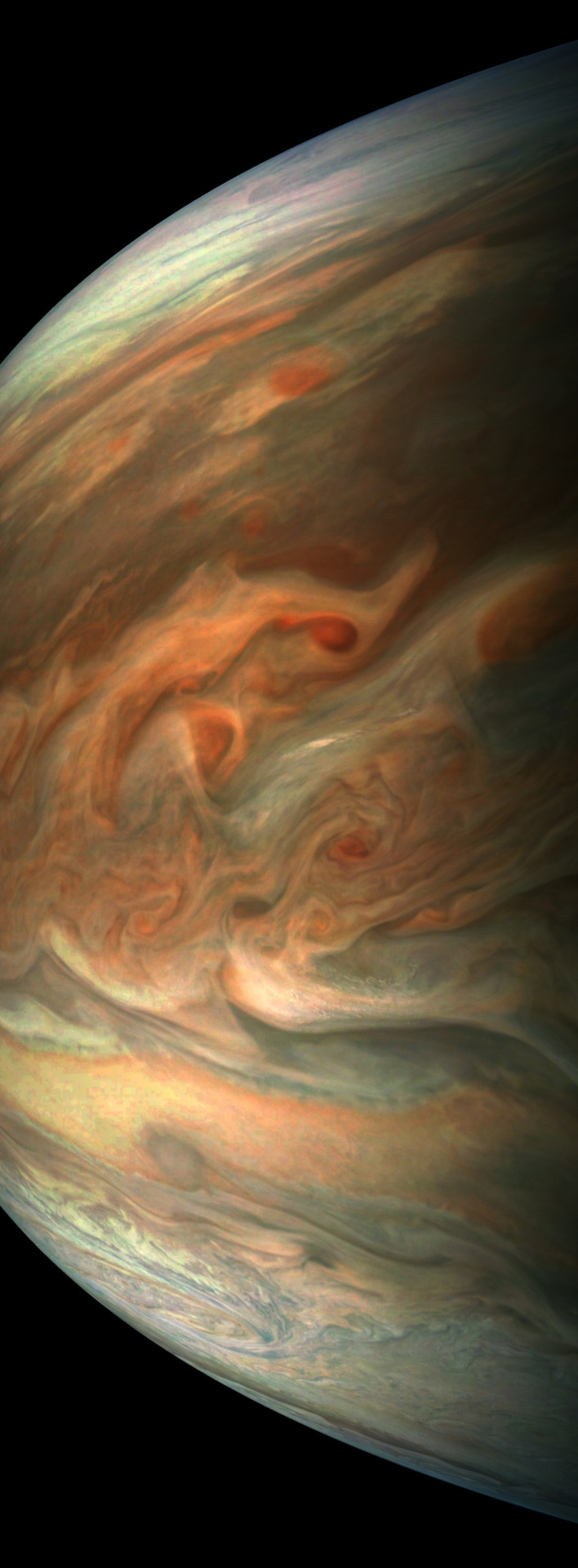
This striking image of Jupiter was taken on Sept. 1, 2017 as Juno performed its eighth flyby. The spacecraft was 4,707 miles (7,576 kilometers) from the tops of the clouds of the planet at a latitude of about -17.4 degrees. Noteworthy: "Whale's Tail" and "Dan's Spot."
7. In true color.
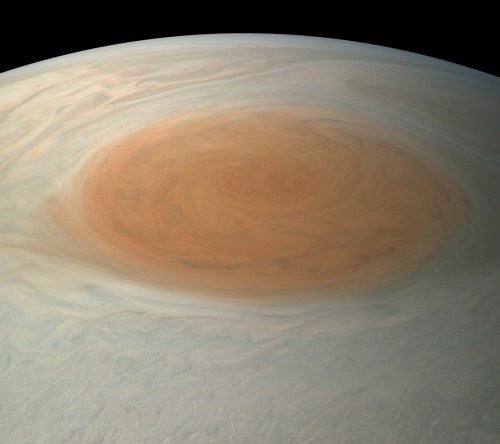
This true-color image offers a natural color rendition of what the Great Red Spot and surrounding areas would look like to human eyes from Juno's position. The image was taken on July 10, 2017 as the Juno spacecraft performed its seventh close flyby of Jupiter.
8. The 'face' of Jupiter.

JunoCam images aren't just for art and science—sometimes they're created for a good chuckle. This image, processed by citizen scientist Jason Major, is titled "Jovey McJupiterface." By rotating the image 180 degrees and orienting it from south up, two white oval storms turn into eyeballs, and the "face" of Jupiter is revealed. The original image was taken by the Juno spacecraft on May 19, 2017.
9. Bands of clouds.

This enhanced-color image of Jupiter's bands of light and dark clouds was created by citizen scientists Gerald Eichstädt and Seán Doran. Three of the white oval storms known as the "String of Pearls" are visible near the top of the image. Each of the alternating light and dark atmospheric bands in this image is wider than Earth, and each rages around Jupiter at hundreds of miles (kilometers) per hour. The lighter areas are regions where gas is rising, and the darker bands are regions where gas is sinking. Juno captured the image on May 19, 2017.
10. The edge.

This enhanced-color image of a mysterious dark spot on Jupiter seems to reveal a Jovian "galaxy" of swirling storms. Juno captured this image on Feb. 2, 2017 and citizen scientist Roman Tkachenko enhanced the color to bring out the rich detail in the storm and surrounding clouds. Just south of the dark storm is a bright, oval-shaped storm with high, bright, white clouds, reminiscent of a swirling galaxy. As a final touch, he rotated the image 90 degrees, turning the picture into a work of art.
To learn more about the Juno mission at Jupiter, visit: www.nasa.gov/juno.
Follow the Juno mission on Facebook, Instagram and Twitter.
Make sure to follow us on Tumblr for your regular dose of space: http://nasa.tumblr.com.
Has the COVID-19 pandemic really reduced pollution in areas participating in lockdowns? Is the environment “recovering”?
Apollo 10 Audio — Publicly Available Since 1970s
Recent news articles have reported that “newly declassified” audiotapes reveal that Apollo 10 astronauts heard “outer-spacey” music as the spacecraft flew around the far side of the moon in 1969.
Here are the facts:

While listed as ‘confidential’ in 1969 at the height of the Space Race, Apollo 10 mission transcripts and audio have been publicly available since 1973. Since the Internet did not exist in the Apollo era, we have only recently provided digital files for some of those earlier missions. The Apollo 10 audio clips were uploaded in 2012, but the mission’s audio recordings have been available at the National Archives since the early 1970s.

As for the likely source of the sounds, Apollo 10 Lunar Module Pilot Gene Cernan told us on Monday, ‘I don’t remember that incident exciting me enough to take it seriously. It was probably just radio interference. Had we thought it was something other than that we would have briefed everyone after the flight. We never gave it another thought.’
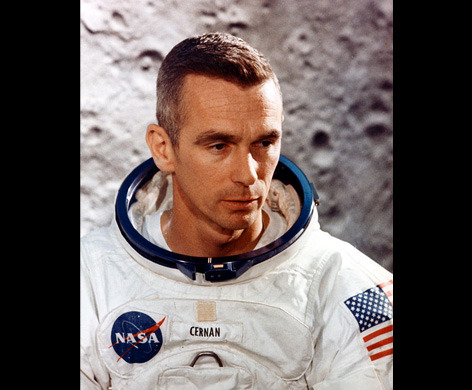
If you’d like to listen to the audio file, it is available HERE (starting at 2:50).
The full transcript is available HERE.
Make sure to follow us on Tumblr for your regular dose of space: http://nasa.tumblr.com
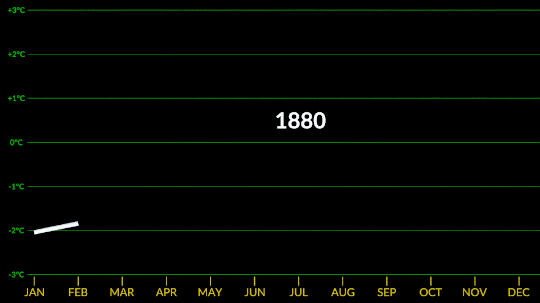
Confirmed: Summer 2023 Hottest in NASA’s Record
All three months of summer 2023 broke records. July 2023 was the hottest month ever recorded, and the hottest July. June 2023 was the hottest June, and August 2023 was the hottest August.
NASA’s temperature record, GISTEMP, starts in 1880, when consistent, modern recordkeeping became possible. Our record uses millions of measurements of surface temperature from weather stations, ships and ocean buoys, and Antarctic research stations. Other agencies and organizations who keep similar global temperature records find the same pattern of long-term warming.
Global temperatures are rising from increased emissions of greenhouse gasses, like carbon dioxide and methane. Over the last 200 years, humans have raised atmospheric CO2 by nearly 50%, primarily through the burning of fossil fuels.
Drivers of climate change, both natural and human-caused, leave distinct fingerprints. Through observations and modeling, NASA researchers confirm that the current warming is the result of human activities, particularly increased greenhouse gas emissions.
GPS: Coming to a Moon Near You!

The next generation of lunar explorers – the Artemis generation – will establish a sustained presence on the Moon, making revolutionary discoveries, prospecting for resources and proving technologies key to future deep space exploration. To support these ambitions, our navigation engineers are developing an architecture that will provide accurate, robust location services all the way out to lunar orbit.
How? We’re teaming up with the U.S. Air Force to extend the use of GPS in space by developing advanced space receivers capable of tracking weak GPS signals far out in space.

Spacecraft near Earth have long relied on GPS signals for navigation data, just as users on the ground might use their phones to maneuver through a highway system. Below approximately 1,860 miles, spacecraft in low-Earth orbit can rely on GPS for near-instantaneous location data. This is an enormous benefit to these missions, allowing many satellites the autonomy to react and respond to unforeseen events without much hands-on oversight.

Beyond this altitude, navigation becomes more challenging. To reliably calculate their position, spacecraft must use signals from the global navigation satellite system (GNSS), the collection of international GPS-like satellite constellations. The region of space that can be serviced by these satellites is called the Space Service Volume, which extends from 1,860 miles to about 22,000 miles, or geosynchronous orbit.

In this area of service, missions don’t rely on GNSS signals in the same way one would on Earth or in low-Earth orbit. They orbit too high to “see” enough signals from GNSS satellites on their side of the globe, so they must rely on signals from GNSS satellite signals spilling over to the opposite side of the globe. This is because the Earth blocks the main signals of these satellites, so the spacecraft must “listen” for the fainter signals that extend out from the sides of their antennas, known as “side-lobes.”

Though 22,000 miles is considered the end of the Space Service Volume, that hasn’t stopped our engineers from reaching higher. In fact, our simulations prove that GNSS signals could even be used for reliable navigation in lunar orbit, far outside the Space Service Volume, over 200,000 miles from Earth. We’re even planning to use GNSS signals in the navigation architecture for the Gateway, an outpost in orbit around the Moon that will enable sustained lunar surface exploration.

It’s amazing that the same systems you might use to navigate the highways are putting us on the path forward to the Moon!
Make sure to follow us on Tumblr for your regular dose of space: http://nasa.tumblr.com.
After 20 years in space, the Cassini spacecraft is running out of fuel. In 2010, Cassini began a seven-year mission extension in which the plan was to expend all of the spacecraft’s propellant exploring Saturn and its moons. This led to the Grand Finale and ends with a plunge into the planet’s atmosphere at 6:32 a.m. EDT on Friday, Sept. 15.
The spacecraft will ram through Saturn’s atmosphere at four times the speed of a re-entry vehicle entering Earth’s atmosphere, and Cassini has no heat shield. So temperatures around the spacecraft will increase by 30-to-100 times per minute, and every component of the spacecraft will disintegrate over the next couple of minutes…
Cassini’s gold-colored multi-layer insulation blankets will char and break apart, and then the spacecraft's carbon fiber epoxy structures, such as the 11-foot (3-meter) wide high-gain antenna and the 30-foot (11-meter) long magnetometer boom, will weaken and break apart. Components mounted on the outside of the central body of the spacecraft will then break apart, followed by the leading face of the spacecraft itself.
Make sure to follow us on Tumblr for your regular dose of space: http://nasa.tumblr.com.
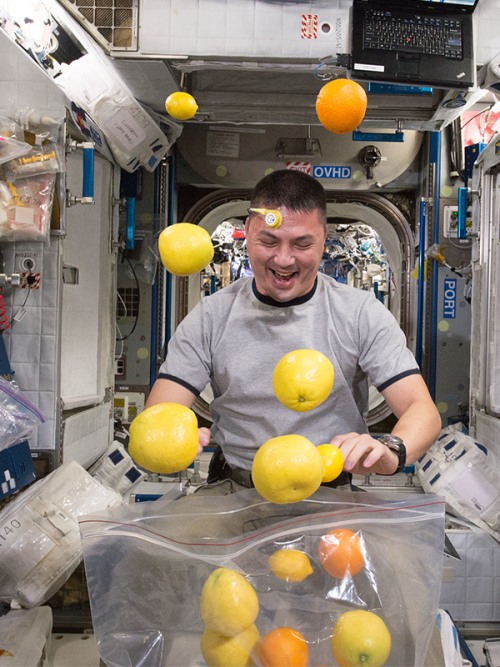
NASA Spotlight: Astronaut Kjell Lindgren
Kjell N. Lindgren was selected by NASA in 2009. Born in Taiwan while his family was stationed overseas, he spent most of his childhood abroad and returned to the U.S. to complete his education and earn a Doctorate of Medicine from the University of Colorado. He is board certified in emergency and aerospace medicine. After serving as the Deputy Crew Surgeon for Space Shuttle mission STS‐130 and Expedition 24, he was selected to join our astronaut corps. Dr. Lindgren flew on the International Space Station from July 2015 to December 2015 and logged 141 days in space. He participated in two spacewalks and in more than a hundred different scientific experiments. In his free time, Dr. Lindgren enjoys spending time with his family, running, reading, movies, photography and amateur astronomy.
He took some time from being a NASA astronaut to answer questions about his life and career! Enjoy:
What is one thing you would take to space that would make life easier?
A real R2 unit, of course! Just kidding, but in the future… Honestly though, life is pretty good on the International Space Station. While it is still a lot like camping (sleeping bags, no running water, rehydrated food) the space station team has really equipped us for success. As you all prepare for YOUR future spaceflight, I would say that the two most useful items I had with me on a daily basis were a pair of scissors and a spoon. The scissors were super useful for cutting plastic wrappers, tape, etc., and opening food packages (much more useful than a knife). And the spoon is the only utensil you need for eating – at least with the food system that we have right now.
Who helped get you to where you are?

Getting this opportunity, becoming an astronaut – that was a team effort for sure. I had so many people walking alongside me on this journey, helping me along the way. My parents set the bit early on – telling me that I could become whatever I wanted through hard work. They really gave me permission to dream big. Teachers and coaches, mentors, co-workers and friends all played a huge part in reaching this goal. Most of all, though, my wife, Kristi and my three kids have been an integral part of this adventure. I would not have this job, and I wouldn’t be successful in it without their love and daily support.
You and your crew mates were the first astronauts to harvest lettuce grown on orbit. How did it taste?

The lettuce tasted like…lettuce, which was a good thing, because if it hadn’t, then it meant we had made a huge mistake. It was so much fun to be a part of that experiment. The payoff, getting to eat fresh grown food on orbit was of course, a lot of fun. But just getting to take care of the lettuce plant, watch it grow in the sterile looking environment of the space station, getting to take care of this living thing on a daily basis, it was good for the soul.
How do you prepare for someone getting hurt or sick in space?
We train at least two crew members on every expedition to be Crew Medical Officers, or CMOs. They spend about 40 – 50 hours learning how to use the medical equipment and procedures on the space station, so that they can essentially serve as an extension of the flight surgeon in mission control. We have equipment and medication to deal with most minor illnesses and injuries. But because we are in low earth orbit, we can evacuate an ill crew member back to Earth in the event of a severe medical issue. This option won’t be available as we push out further from Earth, so we’ll need more rigorous training and a more comprehensive medical system.
How many times did you apply to be an astronaut?

I was very fortunate and got selected on my first try. I have several friends in the office though, who applied 4 or 5 times before being selected. It is amazing to go through the selection process and to meet others who share your dream. Enjoy the experience and keep applying – it is worth it!
How can I improve my chances of being selected to become an astronaut?
I recommend continuing to do things that you enjoy, continue to build experience at work and maybe look for new opportunities in your job that will grow you in your career and grow you as a leader. But choose opportunities because YOU want to do them, not based on what you think NASA is looking for. There is no one path or experience that leads to becoming an astronaut. We have an amazing diversity of experience and background in the astronaut office.
What advice do you have for the newest astronauts?

Enjoy the journey! Spaceflight is amazing, but even as astronauts, most of us spend 95% of our career on the ground. Enjoy every part of the job, supporting missions as a Spacecraft Communicator (CapCom), verifying procedures for a repair or training for a spacewalk. It is amazing to be a part of the team that launches and supports humans living and working in space. It is an amazing thing.
Which is more exciting: spacewalking or skydiving?

Skydiving was pretty amazing. I got to do quite a bit of it as a member of the Air Force Academy parachute team. But there is nothing quite like doing a spacewalk. It is an indescribable experience, putting hundreds of hours of training to work, the physical and mental challenge of operating in that harsh environment. But the view outside the space station, of the Earth, the stars, the structure of the space station – it was a highlight of my time in space and something I will never forget.
What's the most interesting part about training with the Dragon capsule?
It has been awesome working with the NASA and SpaceX teams as we are preparing to launch in the Crew Dragon capsule. My favorite part of the experience has always been and continues to be the people. Safely sending humans to space and back is one of the most difficult things humanity has ever done. That challenge attracts the best and brightest people from across our country. Getting to work with those folks at NASA and at SpaceX, to experience their enthusiasm, dedication and ingenuity on a daily basis is a gift. It has also been a lot of fun seeing a different approach to human spaceflight. I’m very familiar with how NASA and the Russian Space Agency Roscosmos operate. It has been fun seeing a different perspective and approach.
Can you share your favorite photo or video that you took in space?

Yes! This is my favorite photo of the Milky Way, with a lightning strike illuminating a solar array.
Thanks Dr. Lindgren, and good luck on your next spaceflight!
Make sure to follow us on Tumblr for your regular dose of space: http://nasa.tumblr.com.
It’s a Bird! It’s a Plane! It’s NASA’s Five Newest Airborne Campaigns!
We’re not just doing research in space! From the land, the sea and the sky, we study our planet up close. Right now, we’re gearing up for our newest round of Earth Expeditions, using planes, boats and instruments on the ground to study Earth and how it’s changing.

The newest round of campaigns takes place all across the United States – from Virginia to Louisiana to Kansas to California.

The five newest missions will combine measurements from the ground, the sea, air and space to investigate storms, sea level rise and processes in the atmosphere and ocean.
Let’s meet the newest Earth science missions:
1. IMPACTS
The Investigation of Microphysics and Precipitation for Atlantic Coast-Threatening Snowstorms will start from Wallops Flight Facility in Virginia to understand how bands of snow form during winter storms in the East Coast. This research will help us better forecast intense snowfall during extreme winter weather.

2. ACTIVATE
Flying out of Langley Research Center, the Aerosol Cloud Meteorology Interactions over the Western Atlantic Experiment is studying how specific types of clouds over oceans affect Earth’s energy balance and water cycle. The energy balance is the exchange of heat and light from the Sun entering Earth’s atmosphere vs. what escapes back into space.

3. Delta-X
Farther south, Delta-X is flying three planes around the Mississippi River Delta to study how land is deposited and maintained by natural processes. Studying these processes can help us understand what will happen as sea levels continue to rise.

4. DCOTSS
Heading out to the Midwest this summer, the Dynamics and Chemistry of the Summer Stratosphere mission will study how thunderstorms can carry pollutants from high in the atmosphere deep into the lower stratosphere, where they can affect ozone levels.

5. S-MODE
About 200 miles off the coast of San Francisco, the Sub-Mesoscale Ocean Dynamics Experiment is using ships, planes and gliders to study the impact that ocean eddies have on how heat moves between the ocean and the atmosphere.

These missions are kicking off in January, so stay tuned for our updates from the field! You can follow along with NASA Expeditions on Twitter and Facebook.

Make sure to follow us on Tumblr for your regular dose of space: http://nasa.tumblr.com.
Watch the Perseids Meteor Shower With Us!

Credit: NASA/Bill Ingalls
The Perseids meteor shower is here! It's one of the biggest of the year, and will peak early in the morning on Thursday, August 12, 2021 and Friday, August 13, 2021. To spot them, find a dark area away from bright lights (yes, that includes your phone), and let your eyes acclimate to the night sky. But don't worry – if you can't get away from lights, join us on Facebook, Twitter, and YouTube for a meteor shower livestream hosted by our Marshall Space Flight Center's Meteoroid Environment Office. Get all the details on our Watch the Skies blog.
Make sure to follow us on Tumblr for your regular dose of space.
-
 mescalined liked this · 1 year ago
mescalined liked this · 1 year ago -
 oraculojasmineiro liked this · 1 year ago
oraculojasmineiro liked this · 1 year ago -
 conundrums-and-cupcakes liked this · 1 year ago
conundrums-and-cupcakes liked this · 1 year ago -
 willieolsen liked this · 2 years ago
willieolsen liked this · 2 years ago -
 chocolatequeennk reblogged this · 2 years ago
chocolatequeennk reblogged this · 2 years ago -
 turquoisefleur liked this · 2 years ago
turquoisefleur liked this · 2 years ago -
 caitlinsnicket liked this · 2 years ago
caitlinsnicket liked this · 2 years ago
Explore the universe and discover our home planet with the official NASA Tumblr account
1K posts